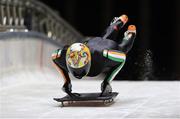The sport of skeleton originates from athletes that descended down the mountains in a toboggan — a wooden sleigh without runners common among Canadian Indians. Luge’s emergence is referenced in literature from the 16th century. Information about luge as a sport dates back to the mid-19th century, when British tourists in the Swiss Alps started going down the snow-covered slopes on a sled.
Skeleton has twice been included in the Olympic Winter Games in the country where it originated, at the Games in St. Moritz in 1928 and 1948. However, skeleton was not adopted as an Olympic discipline until the 2002 Salt Lake City Olympic Winter Games, with athletes going for Skeleton gold again in Sochi in 2014.
Skeleton in Sochi 2014
- A sled with steel runners and a weighted frame without steering, in which the athlete lays face down and head first in direction, controlling the sled using special spikes on their shoes.
- Gloves for athletes are made of leather and protect against damage.
- All athletes wear special durable helmets that protect the head from injury.
- A track suit made of elastic fabric to tightly encircle the body.
- Shoes are made of synthetic material and have spikes on the soles.
Ireland’s Sean Greenwood arrived in Sochi on February 2nd, following a training camp in Konigssee, Germany, and is coached by former world champion and Olympic silver medallist Jeff Pain. Over the past week he and Jeff have been analysing the track, sled set up, and planning their race strategies. He is ranked 26th in the world, with a top 20 Olympic ranking going into competition on the 14-15th February.
Brief description of Skeleton at Sochi 2014
Skeleton involves a descent on a special track with artificially frozen ice in a sled. The Olympic skeleton competition lasts for two days. Each athlete completes a total of four runs. Medals are awarded based on total time over the four runs, with the winner having the lowest overall time. If two athletes complete the competition in a tie, they are awarded the same place. In the Olympic Winter Games program there are singles’ competitions for men and women. There are only two sets of medals to be won in skeleton.
The Sanki Sliding Centre Track
The Sanki Sliding centres highest point is 836 metres above sea level, its lowest point is at 704 metres above sea level and the finish line 711.50 metres. The 1,184 metre course features 17 curves and is te longest and most safest in the world with three ascent sections.


